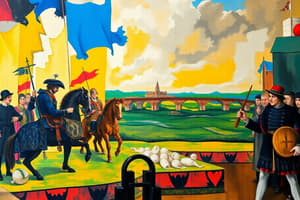Podcast
Questions and Answers
What was the primary purpose of the edict issued by Holy Roman Emperor Ferdinand II during the Thirty Years' War?
What was the primary purpose of the edict issued by Holy Roman Emperor Ferdinand II during the Thirty Years' War?
- To promote Protestant reforms within the Empire
- To restore Catholic property lost to Protestants since 1552 (correct)
- To unify the Holy Roman Empire under a single religious doctrine
- To grant independence to Protestant states
How did the edict affect the Catholic-Protestant conflict within the Holy Roman Empire?
How did the edict affect the Catholic-Protestant conflict within the Holy Roman Empire?
- It resulted in the immediate end of the Thirty Years' War.
- It significantly reduced tensions between Protestant states.
- It reinforced the conflict and prompted further divisions. (correct)
- It led to a complete reconciliation between the two groups.
What were the political consequences of the edict issued during the Thirty Years' War?
What were the political consequences of the edict issued during the Thirty Years' War?
- It unified all states of the Holy Roman Empire in support of Ferdinand II.
- It guaranteed the political power of Protestant leaders.
- It established peace between Catholic and Protestant states.
- It contributed to the decline of the Holy Roman Empire's unity. (correct)
Which response was triggered among Protestant states due to the enforcement of the edict?
Which response was triggered among Protestant states due to the enforcement of the edict?
Which of the following figures was a prominent Protestant leader opposing the edict?
Which of the following figures was a prominent Protestant leader opposing the edict?
Flashcards are hidden until you start studying
Study Notes
Historical Context
- Established during the Thirty Years' War (1618-1648).
- Issued by Holy Roman Emperor Ferdinand II.
- Aimed to restore Catholic property lost to Protestants since 1552.
- Influenced by the Counter-Reformation efforts to consolidate Catholic control.
Religious Implications
- Affirmed Catholic dominance in the Holy Roman Empire.
- Provoked Protestant opposition and further divisions within Christianity.
- Reinforced the Catholic-Protestant conflict central to the Thirty Years' War.
- Seen as an attack on Protestant rights and freedoms.
Political Consequences
- Increased tensions between Catholic and Protestant states within the Empire.
- Led to alliances forming against Ferdinand II among Protestant states.
- Contributed to the weakening of the unity of the Holy Roman Empire.
- Set a precedent for the use of edicts for religious control in the empire.
Impact On The Thirty Years' War
- Intensified hostilities between the warring factions.
- Provoked military responses from Protestant states such as Sweden and Denmark.
- The edict's enforcement exacerbated the conflict, leading to prolonged warfare.
- Influenced territorial and political bargains in later peace treaties.
Key Figures Involved
- Ferdinand II: Holy Roman Emperor who issued the edict.
- Albrecht von Wallenstein: Military leader for the Catholic side, significant in the war's progression.
- Gustavus Adolphus: King of Sweden, a prominent Protestant leader opposing the edict.
- Christian IV of Denmark: Another Protestant leader who opposed Ferdinand II's policies.
The Edict of Restitution (1629)
- Issued during the Thirty Years' War (1618-1648) by Holy Roman Emperor Ferdinand II.
- Aimed to reclaim Catholic Church properties seized by Protestants since 1552.
- Part of the Counter-Reformation, a Catholic movement to regain religious and political dominance.
- Mandated the return of ecclesiastical lands and properties lost by the Catholic Church.
Religious Impact
- Reinforced the Catholic Church's authority in the Holy Roman Empire.
- Deepened religious divisions within the Empire, exacerbating tensions between Catholics and Protestants.
- Viewed by Protestants as an infringement upon their religious freedom and rights.
- Fueled existing religious conflicts and intensified the religious dimension of the war.
Political Ramifications
- Increased political tensions between Catholic and Protestant states within the Empire.
- Triggered alliances among Protestant states against Emperor Ferdinand II.
- Weakened the political unity and stability of the Holy Roman Empire.
- Established a precedent for using edicts to enforce religious policies within the Empire.
Influence on the Thirty Years' War
- Escalated the conflict, leading to further military confrontations.
- Provoked military interventions from Protestant powers such as Sweden and Denmark.
- Contributed to the prolonged nature and intensity of the war.
- Shaped the negotiations and outcomes of subsequent peace treaties.
Key Players
- Ferdinand II: Holy Roman Emperor, the issuer of the edict.
- Albrecht von Wallenstein: A key military commander for the Catholic forces.
- Gustavus Adolphus: King of Sweden, a major Protestant leader who opposed the edict.
- Christian IV of Denmark: Another prominent Protestant king who resisted Ferdinand II's policies.
Studying That Suits You
Use AI to generate personalized quizzes and flashcards to suit your learning preferences.




